Knitwear is a French word that translates as knitted item. Unlike many other fabrics, these items are not interwoven, and are made using knitting. When looped around each other, the loops will merge. The result is a fabric that has elastic properties.
General characteristics
Knitted fabric is a stretchy knitted fabric that follows and fits the contours of the body, and does not restrict the body in movement. In addition, the material is practical, hygienic and does not require complex care. The fabric is suitable for sewing summer and winter clothes.

Knitwear production was already carried out in Ancient Egypt. In the 13th century, similar products began to be produced in Europe, which were represented by scarves, gloves, men's stockings. Initially, the process took place on 2 knitting needles by hand.
In 1589, William Lee invented a knitting machine to make it easier to make knitted stockings. In 1798, a circular knitting machine was created in France that could be used to form knitwear into a tube shape.
Classification
There are several types of canvases that differ from each other in density, appearance, complexity of production and other parameters.
By interlacing
Knitted fabric can be warp-knitted and cross-knitted according to the weaving method. The main structural link of the material is the loop, which includes a connecting drawstring with the frame. Horizontally placed elements create loop rows, and vertical stitches create loop columns.
Warp knitted
In this weave, the warp threads need to be knitted on several needles separately with a shift. As a result, the fabric will have inclined loops in the form of sticks or arcs.
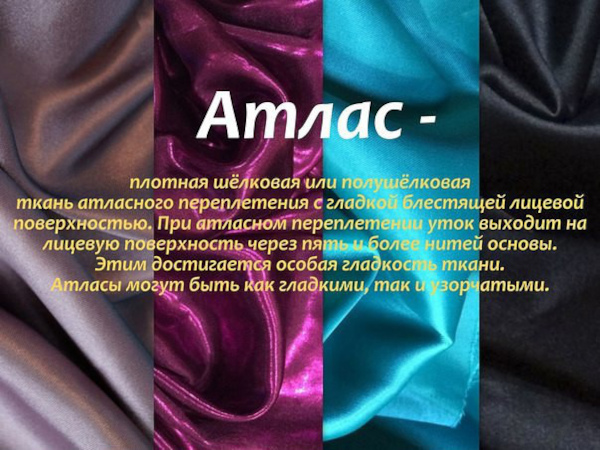
Types of fabrics:
- Atlas. It is a smooth silk or semi-silk material, the front side of which has a glossy surface. This type of fabric is used in sewing pointe shoes, tuxedos, various flags, furniture upholstery, and trim for church items.
- Tights. It is a cotton wool or semi-wool material with a clear pattern. It is often used in sewing suits or dresses.
- Chain. This is a simple weave that is often used to create fringe on scarves and shawls.
Cross-knitted
They are made on the basis of one thread system using one yarn. The result is straight stitches that can be unraveled horizontally and vertically. In the transverse direction, this fabric will be elastic and retain its shape well.
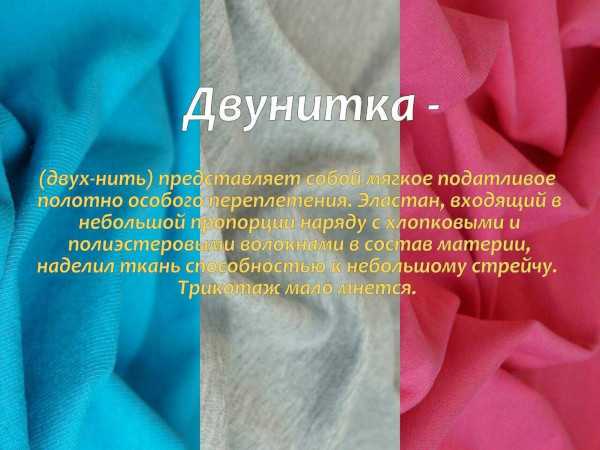
The main types of this fabric are:
- Double thread. It is a dense cotton material, the front side of which looks like a jersey surface, and the back side is characterized by a loop-shaped pattern. Due to the fact that the working material is natural raw materials, the fabric will be breathable but dense. However, if you wash clothes in hot water (more than 30 ℃), the fabric may shrink and deform.
- Interlock. It is a cotton jersey, in the production of which 2 elastics with double weaving are crossed. As a result, each side will be smooth. The material is pleasant to the touch and soft, so it is often used in sewing children's clothes, as well as dressing gowns or pajamas. The main advantages of the fabric are hypoallergenicity with a breathable texture, durability and resistance to mechanical deformation. In addition, the material is elastic, maximally retains its original shape, and also has thermal insulation properties so that the body does not overcool or overheat. However, the fabric requires careful care. For example, if the temperature regime is violated during washing, the item may shrink and change shape in width. To prevent such problems, hand washing should take place at a temperature not exceeding 40 ℃, and machine washing should be delicate and with a minimum spin speed.
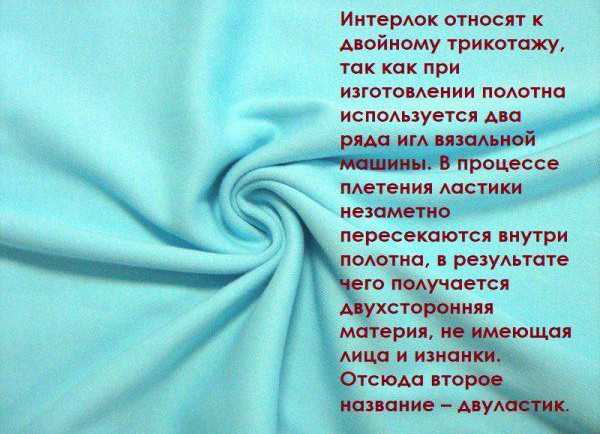
- Cashcorse. Basically, pure 100% cotton is used in production or additives are added. Ribbed knit is a special type of weaving, which is called English elastic. Thanks to this, the fabric will be elastic and will allow the clothes to fit well. The fabric texture is pleasant to the touch, light, breathable, and is not prone to deformation of clothes. However, the material may lose its original shape over a long service life if not properly cared for. In this case, you cannot use bleach, only a mild detergent. You need to wash clothes by hand in warm water not exceeding 40 ℃. For washing in a washing machine, you need to choose a low spin speed. Ironing products made of rib knit requires an iron heated to 150 ℃.
- Knitted surface. It is a thin and light knitted material that is pleasant to the touch and is often used in the manufacture of summer clothes. The fabric is breathable, so with the onset of hot weather it will give the body a comfortable feeling. In addition, the jersey surface consists of environmentally friendly raw materials that prevent the development of an allergic reaction. The material perfectly absorbs moisture and dries quickly, and is also characterized by a low rate of creasing when wearing knitted items.

- Pique. It is a dense knitted material characterized by complex patterned elements in the form of diamonds and squares. The fabric is mainly used in the production of sportswear, such as polo shirts and T-shirts.
- Ribana. The material has a special knitting form, which is called elastic. This is due to the fact that when making the fabric, a surface is formed from purl and face stitches, which alternate with each other in various proportions (for example, 1:1, 2:1 or 2:2). When creating ribana, only natural raw materials can be used (for example, 100% cotton can be present) or other fibers can be added in the form of polyester, elastane, lycra or viscose. The material is characterized by a breathable texture, reliability, elasticity and practicality in use. In addition, ribana retains heat, absorbs sweat, and also retains its original appearance for a long service life. Cotton fabric is mainly used in sewing underwear in the form of T-shirts, children's hats, vests, and panties. To extend the service life, it is necessary to properly care for the clothes. In this case, hand washing should take place at a temperature of no more than 30 ℃, and washing in a washing machine should be done on a delicate program.
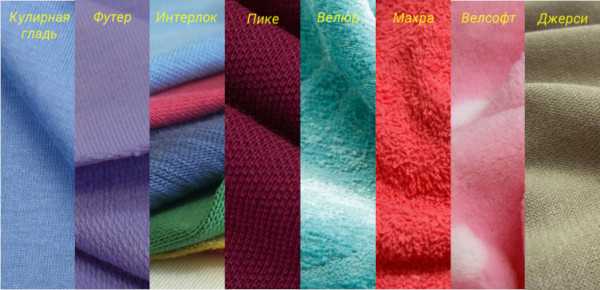
- Footer. Despite the fact that it is a dense cotton material, the clothes are pleasant to the touch. The front part of the footer resembles a jersey smooth surface, but on the back side there is a loop weave with a drawstring to the base. As a result, a unique pile is formed, which gives the fabric softness and a feeling of comfort. The footer can be two- or three-thread, and also consist of synthetic fibers. This type of fabric does not stretch, does not become covered with pellets, absorbs moisture well, and is also hypoallergenic. Due to the breathable cotton, with the onset of hot weather, clothes made of footer will provide a feeling of comfort. However, the material is deformed due to the influence of direct sunlight and exposure to high temperatures. Basically, the fabric is used in sewing cardigans, tracksuits, sweaters, dressing gowns.
By composition
Thread material can include various components, so it can be natural, artificial, synthetic or mixed. As a result, knitted fabric can be synthetic, cotton, mixed, wool.
Natural
Knitted material made of natural threads is pleasant to the body, comfortable and breathable. Due to its strength, softness and affordable price, it is in high demand among consumers. Fabric made of natural fibers, unlike wool, linen, viscose or silk knitted fabric, is easy to sew and care for.
However, clothes made from pure natural materials do not have a long service life and cannot retain their original shape for a long time. At the same time, 100% wool or cotton require delicate care, and after a while, the clothes become covered in pellets.
Artificial
Types of artificial knitted fabric:
- Acetate fabric. It is a synthetic fabric made from processed cellulose. The material is breathable, lightweight, pleasant to the body and flexible, so it is suitable for sewing various things and accessories. However, acetate fabric requires careful care because it is prone to creasing and can also deform during washing. At the same time, the material is not very durable and can be subject to abrasion. It is suitable for making ties, scarves, suits, skirts, blouses, dresses.

- Viscose. Cellulose is used to produce yarn. Various products are created from the thread material using various finishing methods and weaving patterns. Mixing viscose with cotton allows you to create a strong hygienic fabric. If combined with polyester, the fabric will be flexible. To increase stretchability, viscose should be combined with elastane. The material emphasizes the curves of the figure, so it is mainly used in sewing underwear, headwear, sportswear, suits, pullovers, gloves.
Synthetic
Synthetic knitted fabric does not fade, does not wrinkle, and can withstand machine washing. The material also dries quickly. However, the fabric is not breathable and is characterized by strong electrification.

Types of synthetic knitwear:
| Name | Characteristic |
| Acrylic | Characterized by light, smooth and long fibers that are suitable for creating wear-resistant and highly durable fabric. Despite the fact that acrylic is artificial, it will be light and soft, similar to wool. However, according to some criteria, acrylic knitwear is of higher quality than woolen fabric. This is manifested in the fact that the material is strong, smooth and has a clear pattern. Synthetic wool can be used to sew hats, scarves, dresses, sweaters and children's clothing. |
| Polyester | In relation to the thread thickness, the fabric can be thin or dense, so it is suitable for various household and industrial tasks. The material does not get wet, therefore it is intended for sewing sportswear, raincoats and jackets. If the knitted fabric contains 100% cheap polyester, it will act as the top layer of clothing, and the lining will be pure or mixed soft cotton. Thanks to this, you can create the necessary thermoregulatory level with the prevention of the greenhouse effect. |
Mixed
Mixed knitwear may contain natural and synthetic fabrics. Due to this, the material is almost never covered with folds and is more wear-resistant. However, after some time, pellets appear on it.
Natural raw materials are mainly supplemented with lycra or elastane for long service life and to prevent deformation.
Mixed fabrics can be:
- vigonevye (particles of wool with cotton);
- combined (the main component is mixed with an auxiliary one to give the fabric certain properties);
- heterogeneous (the composition includes different fibers, so it will not be possible to distinguish the main thread from the auxiliary one).
By quality
There are several types of knitted fabric by quality. The cost of the material with finished clothes will depend on this. In addition, the type of fabric affects the appearance and wear resistance.
Singing
It is a quality material obtained from processed long cotton fibers. In this case, the fibers are sanded to remove lint.
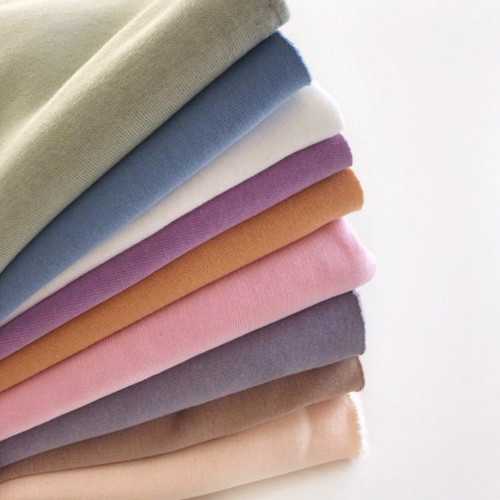
Due to this, the combed fabric:
- smooth;
- wear-resistant;
- has a slight shine;
- strong;
- keeps its shape perfectly;
- almost does not wrinkle or pill;
- almost does not shrink after washing;
- silky.
Compact combed cotton is also a high-quality fabric based on elongated cotton fibers. This type of knitwear is silky and soft, and is almost not subject to the appearance of pellets. Basically, these types of knitted fabric are used in sewing tracksuits, T-shirts, hoodies.
Card (ring)
It is a medium-quality knitted fabric, in the production of which fibers of 27-35 mm in length are used. The material is less resistant to environmental conditions, and also does not retain its appearance well, so there may be a slight pile. The fabric is suitable for the manufacture of sportswear, as well as adult and children's clothing.
Openend
It is a low-quality knitwear, for the production of which short fibers of 20-27 mm in length are used. For this reason, the clothes soon lose their original appearance, wear out and pellets appear on the surface.
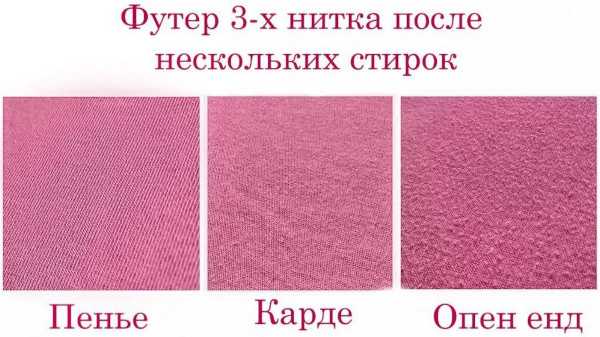
Unlike penye and ring, openend is inexpensive. In this regard, it is often used in the manufacture of advertising items that do not require a long service life. Suitable for sewing children's underwear, pajamas and home items.
By finishing
Knitted fabric can vary in finishing, which directly affects the appearance of the garment.
Harsh
The output of unfinished knitwear occurs at the initial stage of production without further finishing. Suitable for sewing towels, bed linen, bags.
Bleaching
The canvas is lightened to a uniform state so that the shade is white or soft cream. Bleaching can be an independent method of processing or preparatory for the next stage.
Painted
Suitable for color dyeing in one tone, so that the front and back sides of the knitwear have the same shade. Fabrics with the same color can be used for sewing home textiles, clothing and creating drapery.
Stuffed
Unlike simple knitted fabric, printed material has an additional thread layer to strengthen the fabric and give the product a relief appearance with volume. Polyester, viscose, and cotton are mainly used in the production of printed fabrics.
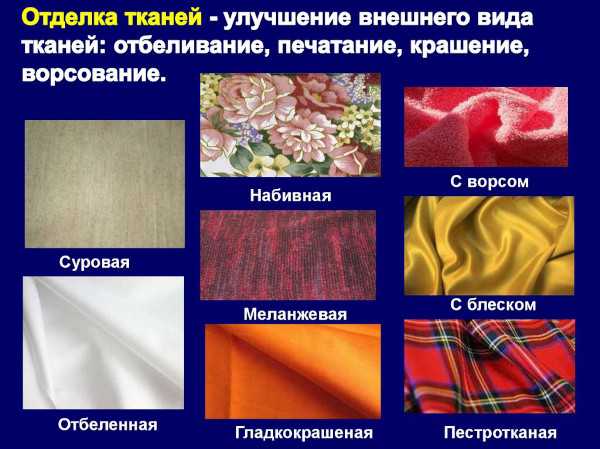
This type of knitwear is suitable for making children's, everyday, sportswear, accessories and headwear.
Combed
The front side of the fabric will be smooth, and the back side will have a warm fleece. Due to this, the clothes will warm the body, like natural wool. This type of knitwear is suitable for creating home, children's clothes and sports suits.
Variegated knitted
In the production of variegated fabrics, dyed thread fibers are intertwined to create a multi-colored knitted material. Suitable for making swimwear, as well as children's and women's underwear.
Embossed
Embossing gives the knitwear a beautiful and textured surface. Before processing, a special solution is initially applied to the fabric to prevent deformation of the material under the influence of high temperatures.
This stage is required for hot stamping. To perform the processing without thermal impact, use dense knitwear with a loose structure.
With the presence of special treatments
In order for knitted fabric to have antistatic properties, the material must undergo special treatment. For these purposes, antistatic threads are included in the fabric, which can be carbon, metallized or metallic.
As a result, a striped or cellular pattern is formed on the surface of the product, which was created by these threads. Carbon type threads can be mixed with pure cotton or mixed knitwear. The material is suitable for sewing special work clothes.
By manufacturing method
Knitted fabric is classified according to the production method, so it can be knitted, cut or mixed.
Tailored
The size and shape are acquired in the process of cutting the knitwear and further sewing. Mainly, underwear is created from cut material.
Knitted
It can be regular and semi-regular. In the first case, the knitwear is given a shape during knitting, and in the sewing process the material gets its final appearance. Hosiery and outer knitwear fabrics can be regular.
Partial formation of the details for semi-regular knitwear occurs during knitting. When the cutting stage comes, the fabric acquires its final appearance.
Combined
In this case, the knitted fabric may contain both cut and knitted elements.
By appointment
For consumers, the classification of knitted fabric by purpose is considered the most important.
Upper
Different fiber compositions are used to produce fabrics, but mainly double ones, which hold their shape well.
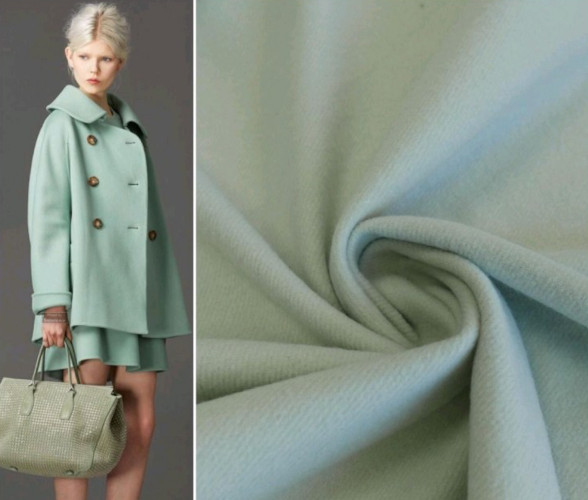
Outerwear can be presented:
- trousers, shorts;
- outerwear;
- dresses, skirts;
- sweaters, jumpers;
- robe, overalls.
Linen
Underwear knitwear is characterized by wear resistance and hygiene, so it is suitable for the production of pantaloons, rompers, pajamas, panties, negligees. Wool, cotton or mixed types of threads can be used for the production of underwear knitwear.
Hosiery
Various knitted weaves are used, but mainly openwork, satin or rib. The material is suitable for sewing leggings, socks, stockings.
Glove
Pure or mixed natural (for example, cotton with wool) and chemical fibers are used for production. But mainly nylon with viscose, cotton and wool fibers are used. Glove knitwear includes gloves with mittens.
For headscarves and shawls
For the production of shawl and scarf knitwear, synthetic and artificial fibers with cotton, semi-woolen or pure wool material are mainly used.

Examples of clothing:
- tie;
- balaclava;
- hats with berets;
- scarves with shawls.
Knitwear is a versatile type of fabric used in almost every branch of the fashion and textile industries.
Textile factories produce various types of material that differ from each other in composition, weaving method and decor. Knitted products are characterized by a beautiful appearance and easy care.
Video about knitted fabric
Types of knitted fabrics:
